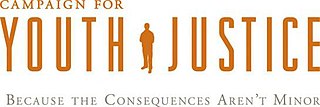
Juvenile delinquency, also known as "juvenile offending", is the act of participating in unlawful behavior as a minor or individual younger than the statutory age of majority. For example, in the United States of America a juvenile delinquent is a person who is typically below 18 years of age and commits an act that otherwise would have been charged as a crime if they were an adult. Juvenile crimes can range from status offenses, to property crimes and violent crimes.
NISMART or the National Incidence Studies of Missing, Abducted, Runaway and Throwaway Children, was a research project supported by the United States Department of Justice. It was enacted to address the 1984 Missing Children's Assistance Act. This required the Office of Juvenile Justice and Delinquency Prevention (OJJDP) to conduct periodic national incidence studies to determine the actual number of children reported missing and the number recovered. The first study, NISMART-1 in 1988 categorized the various missing children reports and estimated the number of missing and recovered children in each. In 1999, a second study dubbed NISMART-2 was initiated. The two studies cannot be compared against each other due to categorizing techniques being distinct in each study. Also, NISMART-2 interviewed youth directly whereas NISMART-1 did not.

A juvenile court is a tribunal having special authority to pass judgements for crimes that are committed by children who have not attained the age of majority. In most modern legal systems, children who commit a crime are treated differently from legal adults that have committed the same offense.

In criminal justice systems a youth detention center, known as a juvenile detention center (JDC), juvenile detention, juvenile hall, or more colloquially as juvie/juvy, also sometimes referred as observation home or remand home is a prison for people under the age of 21, often termed, to which they have been sentenced and committed for a period of time, or detained on a short-term basis while awaiting trial or placement in a long-term care program. Juveniles go through a separate court system, the juvenile court, which sentences or commits juveniles to a certain program or facility.

The Office of Juvenile Justice and Delinquency Prevention (OJJDP) is an office of the United States Department of Justice and a component of the Office of Justice Programs. The OJJDP publishes the JRFC Databook on even numbered years for information on youth detention.

The American juvenile justice system is the primary system used to handle minors who are convicted of criminal offenses. The system is composed of a federal and many separate state, territorial, and local jurisdictions, with states and the federal government sharing sovereign police power under the common authority of the United States Constitution. The juvenile justice system intervenes in delinquent behavior through police, court, and correctional involvement, with the goal of rehabilitation. Youth and their guardians can face a variety of consequences including probation, community service, youth court, youth incarceration and alternative schooling. The juvenile justice system, similar to the adult system, operates from a belief that intervening early in delinquent behavior will deter adolescents from engaging in criminal behavior as adults.
A young offender is a young person who has been convicted or cautioned for a criminal offense. Criminal justice systems often deal with young offenders differently from adult offenders, but different countries apply the term "young offender" to different age groups depending on the age of criminal responsibility in that country.
Juvenile law pertains to those who are deemed to be below the age of majority, which varies by country and culture. Usually, minors are treated differently under the law. However, even minors may be prosecuted as adults.
This page is primarily concerned with juvenile delinquency in the United States. For information on juvenile delinquency in general, see juvenile delinquency. In addition, although the term juvenile delinquency often refers to juvenile as both the victims and the aggressors, this page only refers to juveniles as the actual delinquents. The information and statistics for juveniles as victims rather than offenders is much different. For information about juveniles as the victims of violent attacks, see trafficking of children, child abuse, child sexual abuse, or prostitution of children.

The Second Chance Act of 2007, titled "To reauthorize the grant program for reentry of offenders into the community in the Omnibus Crime Control and Safe Streets Act of 1968, to improve reentry planning and implementation, and for other purposes," was submitted to the House by Representative Danny Davis (D-IL) to amend the Omnibus Crime Control and Safe Streets Act of 1968 to reauthorize, rewrite, and expand provisions for adult and juvenile offender state and local reentry demonstration projects to provide expanded services to offenders and their families for reentry into society. H.R. 1593 was signed into law April 9, 2008.

The United States incarcerates more of its youth than any other country in the world through the juvenile courts and the adult criminal justice system, which reflects the larger trends in incarceration practices in the United States. In 2010, approximately 70,800 juveniles were incarcerated in youth detention facilities alone. As of 2006, approximately 500,000 youth were brought to detention centers in a given year. This data does not reflect juveniles tried as adults. As of 2013, around 40% were incarcerated in privatized, for-profit facilities.
Trial as an adult is a situation in which a juvenile offender is tried as if they were an adult, whereas they will receive a long sentence at a young age.

The Campaign for Youth Justice (CFYJ) is a national campaign in the United States dedicated to ending the practice of trying, sentencing, and incarcerating children under age 18 in the adult justice system. Founded in 2005, CFYJ has become a national clearinghouse on the issue of trying youth in adult court. It is also one of the leading advocates for the reauthorization of the Juvenile Justice and Delinquency Prevention Act. CFYJ is an advocacy group with nonprofit status.
The Illinois Department of Juvenile Justice (IDJJ) is the code department of the Illinois state government that acts as the state juvenile corrections agency.
The North Carolina Department of Juvenile Justice and Delinquency Prevention (DJJDP) was a state agency of North Carolina, headquartered in Raleigh. The agency operates juvenile corrections facilities in the state. It is now a part of the North Carolina Department of Public Safety.
Raising the age of juvenile jurisdiction in the state of North Carolina has been an ongoing issue in the North Carolina General Assembly. There are currently two pieces of legislation focusing on this issue, Senate Bill 506 and House Bill 632, which seek to raise the age of jurisdiction from 16 to 18. Four members of the North Carolina House of Representatives serve as the primary sponsors and there are twenty-six co-sponsors. Most of U.S. States define an adult at 18 years old; however, North Carolina and New York define a juvenile who has committed a criminal offense as no older than 16, which places 16- and 17-year-olds in a position where they are tried as adults for any offense.

The Missing Children's Assistance Reauthorization Act of 2013 is a bill that was introduced into the United States House of Representatives during the 113th United States Congress. The Missing Children's Assistance Reauthorization Act of 2013 reauthorizes the Missing Children's Assistance Act and authorizes $40 million a year to fund the National Center for Missing and Exploited Children.

Gender responsive approach for girls in the juvenile justice system represents an emerging trend in communities and courts throughout the United States, Australia and Latin America, as an increasing number of girls are entering the juvenile justice system. A gender responsive approach within the juvenile justice system emphasizes considering the unique circumstances and needs of females when designing juvenile justice system structures, policies, and procedures.

Criminal justice reform addresses structural issues in criminal justice systems such as racial profiling, police brutality, overcriminalization, mass incarceration, and recidivism. Reforms can take place at any point where the criminal justice system intervenes in citizens’ lives, including lawmaking, policing, sentencing and incarceration. Criminal justice reform can also address the collateral consequences of conviction, including disenfranchisement or lack of access to housing or employment, that may restrict the rights of individuals with criminal records.
The Runaway and Homeless Youth Act is a US law originally passed in 1974 as Title III of the Juvenile Justice and Delinquency Prevention Act. The bill sets the federal definition of homeless youth, and forms the basis for the Runaway and Homeless Youth Program, administered by the Family and Youth Services Bureau. It has been reauthorized multiple times, and is due for re-authorization as of March 2018.









